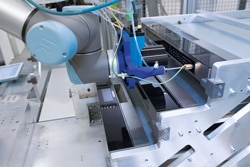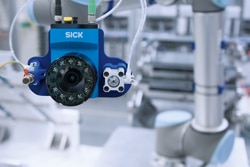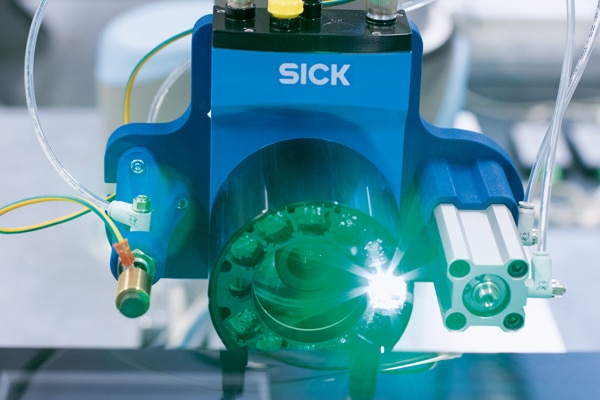At the test labs in one of the worlds largest and most cutting-edge dishwasher factories, BSH Hausgeräte GmbH has invested in a fully automated robot to conduct lifecycle tests on dishwasher panels. This robot is actively controlled by a programmable camera. The robot takes over all aspects of operating the machine, relieving strain from the testing Team.
Dishwashers are some of the most traditional kitchen and household appliances in Germany. In 2015, 63% of all households had a dishwasher. Newer models are adapting to trends in the world of kitchen design in terms of their functionality and appearance. Changes to the design also require production parameters to be adjusted and can also affect factors such as quality control.
Touchpads replace buttons
The latest generation of BSH dishwashers do not come with conventional control panels and moving pushbuttons. Instead, they are equipped with a printed thin-film transistor (TFT) display. To operate the dishwasher, all you have to do is touch one of the program icons on the display. To make sure the control panels work reliably throughout their entire service life, the company had to develop innovative lifecycle tests for the pilot series of the panels, during which they pass through hundreds of demanding test cycles. To make things easier for the testing staff, BSH is using a new mobile robot system that tests the usability of the machines panels in complete test cycles.
Test lab for conducting lifecycle tests on dishwasher control panels
The lab for testing the service life of dishwasher control panels needs to be equipped with a wide array of technology, including solutions for operating certain keys. For this, we need to use a new type of technology based on touch sensors. In this area, it is very important to make sure that the key is positioned with accuracy and precision that allows for repeatability, explains Hans Peter Maurer, the Head of Testing, Quality Management, Product Division Dish Care at BSH, describing the challenges the team faced. We want to measure the signals emitted while the key is activated with a very high level of accuracy. We are keen to find out whether these indicators actually change during the machines service life and beyond. In light of this aim, we have to keep the influencing parameters generated during testing as low as possible and the precise positioning of the activating element is one very important parameter. In its role as the integrator, the company attentra from Tübingen in Germany opted for the new programmable 2D Inspector P65x camera by SICK and then programmed a suitable piece of application software (sensor app). Specializing in vision technology, attentra develops end-to-end solutions for industrial image processing and industrial Automation.
A solution using a programmable camera
 Test lab for conducting lifecycle tests on dishwasher control panels: Mobile robot system conducts entire test cycles.
Test lab for conducting lifecycle tests on dishwasher control panels: Mobile robot system conducts entire test cycles.
The robot was already set up. We simply programmed the sensor app in a way that allows the camera to use a recurring feature to find the control panel in the space. In this case, we were able to identify a very good and very stable feature for image processing. We can then use this feature to determine the position where the keys are located. This means we capture an image: the app conducts its search and measures the position. It then sends the resulting offset values to the robot, which moves to the point in question with full repeatability. This process saves having to attach a feature to the panel, explains Christian Vollrath, Managing Director at attentra GmbH. The test system has enough capacity for 16 control panels. The robot then deals with these 16 panels automatically.
The testing process
 The robot uses the testing fingers on its arm to check each individual key on the dishwasher control panel.
The robot uses the testing fingers on its arm to check each individual key on the dishwasher control panel.
When new control panels or variants are available for testing, they are first mounted individually into the testing slots before being connected to a laptop. The operator then selects the panel variant on the robots control panel and adjusts any necessary settings. This makes sure that the robot knows where the keys on the panel variant are located. Once the test process has started, the robot guides the camera to the first reference position, where it takes a picture, determines the position data of the symbol detected, and then sends this data to the robot control unit. This actively brings the robot arm in line with the reference picture so that it sits directly over the center of the image. The robot now uses the testing fingers on its arm to check each individual key. On the laptop screen, the user sees the current image from the camera, with a green symbol indicating that the reference feature has been detected correctly. Once all of the keys on a panel have been tested, the robot moves the camera to the next panel and the process starts from the beginning again with the search for and evaluation of the reference feature. Prior to series approval, up to 50 panels from a single variant can therefore be tested and subjected to statistical analyses until the variant can finally be approved. For faster thorough checks related to the expected product service life, the testing department uses accelerating influences, such as temperature or moisture, to subject the components to a certain level of load. The InspectorP65x camera brings the robot arm and testing fingers perfectly in line with the control panel so that our testing fingers hit the individual keys with accuracy. One benefit of the InspectorP65x is that it actively controls our robot and can run all night long. This means that the camera helps to increase efficiency and throughput enormously. It is also important to note that precision has increased enormously as a result of using the camera. We would never have achieved this when judging by eye or using a mechanical system, sums up Hans Peter Maurer.
SICK AppSpace for tailor-made application solutions
 The programmable 2D InspectorP65x camera actively controls the robot arm.
The programmable 2D InspectorP65x camera actively controls the robot arm.
The programmable InspectorP65x camera is part of the innovative eco-system, SICK AppSpace, which is made up of programmable sensors, cameras, other programmable products, and a software platform. The high image resolution, the compact housing, exchangeable optics, and a choice of illumination make the InspectorP65x the ideal combination of performance and flexibility. With the HALCON image processing library, installed as standard, even the most challenging application demands can be met. Users do not need to worry about acquiring a runtime licens as it is included with the InspectorP65x as standard. An integrated web server makes it possible to visualize a graphical user interface on any browser-compatible display device.
The built-in App Engine is the only thing needed to ensure that all SICK AppSpace-compatible devices can be programmed. The software development kit SICK AppStudio is used to develop customer-specific application programs on a PC. When it comes to creating sensor apps, users can use programming technology such as graphical flow editors, Lua script programming, and the options of C++ or Java programming. HALCON image rocessing rocedures can also be integrated. Helpful tools such as emulators, debuggers, resource monitors, and an extensive range of documentation and demo apps make the development process easy. The user interface for machine operators can be created individually as a web GUI using the graphical ViewBuilder. The Package-Builder combines all the software components to make a single package that safely defines access rights. The shared development environment needed to create a wide range of SICK products provides a high level of investment security. Because the sensor apps can be reused on various programmable sensors, the amount of development work needed is reduced. Furthermore, existing solutions can be adjusted to future tasks on site at a later date.
And theres more...
The SIM4000 Sensor Integration Machine - part of the SICK AppSpace eco-system - is also opening up new opportunities for application solutions. Data from sensors and cameras from SICK can be merged into a point cloud, evaluated, archived, and transmitted. 8-gigabit Ethernet interfaces are available for 2D or 3D cameras, and in some cases feature power over Ethernet (PoE). Sensors can be integrated via IO-Link for distance and height measuring purposes. Thanks to the high-performance multi-core processor featuring hardware support, the SIM4000 enables image preprocessing and handling of input and output signals in real time. The integrated HALCON library also makes it possible to find solutions for sophisticated image processing Tasks.
- Product information: InspectorP65x
- More information: BSH Hausgeräte GmbH , attentra



